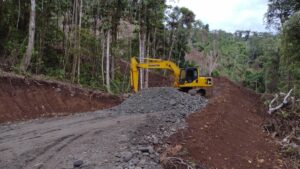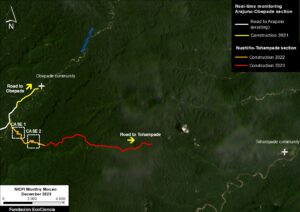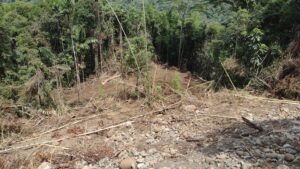
MAAP #204: New Road Construction in Waorani Indigenous Territory (Ecuadorian Amazon)
January 24, 2024
 We analyze a new road project that enters the western sector of the Waorani Indigenous Territory, located in the heart of the Ecuadorian Amazon (see Base Map, below).
We analyze a new road project that enters the western sector of the Waorani Indigenous Territory, located in the heart of the Ecuadorian Amazon (see Base Map, below).
The project, called “Construction of the Arajuno-Nushiño-Ishpingo-Toñampade Road”, has been designed in response to the mobility needs of eight Waorani communities in the area, including Toñampade, the most populated community in the territory.
This road would cross 42 kilometers of primary forest from the Nushiño River to the community of Toñampade. Therefore, there is great potential to open new deforestation fronts along the route.
This road project was managed, approved, and promoted through the Waorani Nationality of Ecuador (NAWE) and its construction is led by the Provincial Government of Pastaza.
The Environmental Impact Study and Management Plan for this road was prepared in 2016 and approved in 2018 and mentions the importance of protecting the biodiversity of the area and the cultural importance of the Amazon rainforests in the Waorani Territory.
In March 2023, the Waorani Organization of Pastaza (OWAP) presented a complaint to the Ministry of the Environment, in which it requested to suspend the construction of the road until the protection of the ecosystems is ensured.
In July, an assembly convened by the NAWE was held to discuss the road project, in which a consensus was sought with the OWAP to restart construction. The agreement was obtained that both Waorani entities, and the communities of Pastaza, will provide monitoring and control so that the technical specifications of the Environmental Impact Study and Management Plan are met.
The objective of this report is to analyze the current state of the road, focused on deforestation caused by the construction (see Image 1), and the actions carried out by Waorani organizations to monitor the project.
Base Map of the Road Project
The Base Map shows the location of the project “Construction of the Arajuno-Nushiño-Ishpingo-Toñampade Road”, located in the heart of the Ecuadorian Amazon.

Road Construction
To document the current state of the road, we analyzed satellite imagery from September 2021 to January 2024. We found a total of 15.8 kilometers of construction (see Image 2).
In September 2021, the construction of the road section towards the community of Obepade was carried out, extending the previously built road from Arajuno (white line), with a new additio of 2.1 kilometers (yellow line).
From July 2022 to July 2023, construction was carried out from the Nunshiño River, reaching a total of 13.7 km towards Toñampade (orange and red lines). There is no evidence of new construction since July 2023, likely due to the above-noted complaint from OWAP.
Thus, the project still needs to construct 28.3 km through primary forest to reach Toñampade.

Territorial Monitoring of Road Construction

In 2022, the Waorani Nationality of Ecuador – NAWE, through its territorial technical team Kenguiwe, carried out the first territorial monitoring and surveillance tours to identify the environmental and social impacts of road construction.
Two cases were discovered where the construction of the road has generated deforestation processes along the route. See the location of these two cases in Image 2.
In the first case, an area of 0.54 hectares was deforested as a consequence of the construction of the road (Image 3). Potentially this deforestation process occurred to find alternative routes to the road.
In the second case, 5.27 hectares was deforested, additionally leading to a mudslide.

Monitoring by the Waorani Nationality of Ecuador
Here we present a series of photographs from the territorial monitoring by the Waorani Nationality of Ecuador, investigating the impacts of the new road construction. All photo credits to the NAWE monitoring program.




Acknowledgments
We thank NAWE for facilitating and authorizing the use of the information and images generated by the monitoring work carried out by its technical team called “Kenguiwe”, with financial support from the EcoCiencia Foundation and the French Development Agency (AFD) through the TerrIndigena Project.
This report is part of a series focused on the Ecuadorian Amazon through a strategic collaboration between the organizations Fundación EcoCiencia and Amazon Conservation, with the support of the Norwegian Development Cooperation Agency (Norad).






















